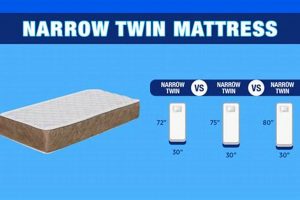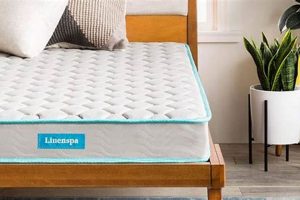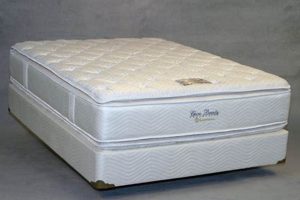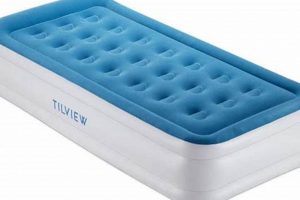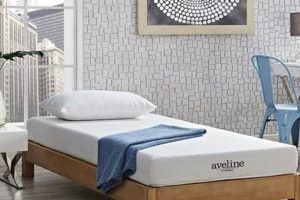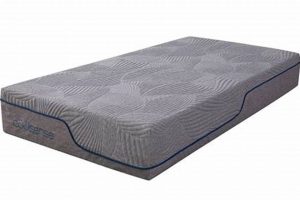A standard dimension sleeping surface designed for use in elevated sleeping structures, typically intended for children or spaces with limited floor area, is characterized by specific length and width measurements. These measurements adhere to the conventional “twin” standard for mattresses, ensuring compatibility with widely available bedding and accessories. For instance, a mattress of this description will generally measure approximately 39 inches wide and 75 inches long.
Adherence to this dimensional specification is critical for safety and functionality. Employing appropriately sized bedding prevents hazards such as slippage or entrapment, especially important in the context of elevated beds used by younger individuals. The utilization of a standard size also streamlines the process of acquiring suitable linens, blankets, and protective covers, facilitating maintenance and ensuring a comfortable sleep environment. Historically, this dimensional standard arose to maximize space efficiency in shared sleeping quarters, and continues to be relevant in modern applications such as dormitories and small apartments.
Understanding the nuances of selecting an appropriate sleeping surface for elevated beds involves considering factors beyond mere dimensions. Material composition, construction, and safety certifications each play a significant role in creating a secure and comfortable sleeping environment. Subsequent sections will delve into these critical aspects, providing a detailed overview of the key considerations for optimizing sleep quality and safety within the context of elevated bedding arrangements.
Selecting an Appropriate Mattress
The following guidelines offer crucial considerations when procuring sleeping surfaces designed for elevated bedding systems. Prioritizing safety and comfort ensures a positive user experience.
Tip 1: Adhere to Manufacturer Specifications: Always consult the elevated bed frame manufacturer’s guidelines regarding maximum thickness restrictions. Exceeding this limit may compromise safety railing height, potentially leading to falls.
Tip 2: Prioritize Fire Safety: Verify that the chosen mattress meets or exceeds relevant fire safety standards and regulations. Look for certifications indicating compliance with established safety protocols to minimize potential fire hazards.
Tip 3: Consider Mattress Material: Evaluate the material composition, taking into account factors such as breathability, support, and allergen resistance. Options like memory foam, innerspring, and latex offer varying levels of comfort and suitability based on individual needs and preferences.
Tip 4: Assess Weight Capacity: Ensure the selected mattress is rated to accommodate the intended user’s weight, with a safety margin to account for movement and additional weight. Exceeding the weight limit can damage the mattress and compromise the structural integrity of the bed frame.
Tip 5: Evaluate Edge Support: Look for models with reinforced edge support. Adequate edge support enhances stability and prevents the sensation of rolling off the mattress, contributing to a more secure sleep environment.
Tip 6: Check for Proper Fit: Upon delivery, verify that the sleeping surface fits snugly within the bed frame, leaving no excessive gaps. Gaps pose a potential entrapment hazard, especially for younger users.
Tip 7: Consider Long-Term Durability: Invest in a mattress constructed with high-quality materials and robust construction techniques to ensure longevity and sustained performance. A durable mattress offers long-term value and reduces the need for frequent replacements.
Selecting a mattress that adheres to these guidelines is paramount to ensuring safety, comfort, and optimal sleep quality. Paying close attention to these factors results in a secure and restful sleep environment.
The subsequent sections will delve into the long-term care and maintenance of mattresses, further enhancing safety and extending the product’s lifespan.
1. Standard dimensions (39" x 75")
The designation “Standard dimensions (39″ x 75″)” directly defines the physical parameters of a specific sleeping surface intended for use in elevated, typically space-saving, bed configurations. This dimensional specification is fundamentally intertwined with the selection and compatibility of a mattress for such applications.
- Dimensional Compatibility
The 39-inch width and 75-inch length represent the established industry standard for “twin” mattresses. This standardization ensures that a mattress manufactured to these specifications will integrate seamlessly with bed frames designed to accommodate this size, including those intended for elevated beds. Deviations from these dimensions may result in instability, safety hazards, or an inability to properly install the mattress within the designated frame.
- Space Optimization
The utilization of the 39″ x 75″ specification allows for efficient space utilization, a primary benefit of elevated bed systems. These beds are often employed in environments where maximizing floor space is crucial, such as dormitories, children’s rooms, and small apartments. The standard dimensions permit the stacking of sleeping surfaces without unduly compromising available room area.
- Safety Considerations
Adherence to the established dimensions is paramount for safety. A mattress that is either too large or too small for the designated frame can create gaps, posing a risk of entrapment, particularly for younger users. Furthermore, an ill-fitting mattress may not be adequately supported, increasing the likelihood of collapse or instability.
- Bedding Availability
The ubiquity of the 39″ x 75″ specification translates to a broad availability of compatible bedding accessories. Sheets, blankets, and mattress protectors designed for “twin” mattresses are readily accessible, simplifying the process of outfitting elevated beds with appropriate linens and protective coverings.
In summary, the “Standard dimensions (39″ x 75″)” designation is not merely a measurement; it is a critical determinant of safety, functionality, and compatibility within the context of elevated bedding systems. Compliance with this standard ensures optimal space utilization, minimizes potential hazards, and facilitates the acquisition of appropriate bedding materials, all essential factors in creating a secure and comfortable sleep environment.
2. Thickness limitations
Thickness limitations are a critical component when considering sleeping surfaces for elevated beds. While the width and length adhere to the standard twin size (approximately 39″ x 75″), the vertical dimensio
n demands careful attention due to its direct impact on safety. The space between the top of the sleeping surface and the upper edge of the guardrail must meet specific regulatory requirements to prevent falls. A mattress exceeding the manufacturer’s recommended thickness reduces this critical safety zone, potentially nullifying the protective function of the guardrail. For example, a bed frame designed for a maximum 6-inch thick sleeping surface coupled with an 8-inch mattress would significantly compromise safety, creating a scenario where a child could easily roll over the guardrail during sleep. This underscores the cause-and-effect relationship: exceeding prescribed thickness directly causes a reduction in guardrail effectiveness.
The implementation of appropriate thickness constraints further extends to the selection of bedding. Thicker sleeping surfaces, while potentially offering enhanced comfort, may require specialized deep-pocketed sheets that can accommodate the increased vertical dimension. This becomes a practical consideration as standard twin-size sheets may not properly fit, leading to potential slippage and discomfort. In certain instances, the inclusion of a thick mattress can also affect the overall aesthetic of the bed. An excessively thick sleeping surface may appear disproportionate, detracting from the intended design of the elevated structure.
In summary, the limitations imposed on the vertical dimension are inextricably linked to the safety and functionality of elevated bedding systems. Ignoring these restrictions can lead to hazardous conditions, emphasizing the need for strict adherence to manufacturer guidelines regarding maximum thickness. Understanding this relationship is not merely a recommendation but a crucial element in ensuring a secure sleep environment, particularly for children and other vulnerable users. Prioritizing safety requires careful consideration of thickness limitations within the overall context of selecting a properly sized and compatible sleeping surface.
3. Weight capacity
Weight capacity, when considered in the context of mattresses designed for elevated sleeping structures, is a crucial safety parameter. This parameter dictates the maximum load a mattress can bear without compromising its structural integrity or the support system of the associated bed frame. The dimensions of the mattress, conforming to the standard twin size, directly influence the weight distribution and, consequently, the overall weight-bearing capability.
- Structural Integrity of Materials
The materials used in the construction of the mattress play a pivotal role in its weight capacity. High-density foams, reinforced innerspring systems, and durable coverings contribute to a more robust structure capable of supporting heavier loads. For instance, a mattress with low-density foam may exhibit premature sagging or compression under significant weight, potentially leading to discomfort or even structural failure over time. The selection of appropriate materials, therefore, directly impacts the mattress’s ability to withstand the intended weight for its lifespan.
- Bed Frame Compatibility and Stress Distribution
The design and construction of the elevated bed frame are intrinsically linked to the mattress’s weight capacity. An inadequate or poorly designed frame may concentrate stress on specific areas of the mattress, exceeding its designed load-bearing limits. For example, a frame with insufficient support slats or a weak central beam may cause the mattress to buckle or deform under weight, even if the mattress itself possesses a high weight capacity. Proper frame design and material selection are essential for distributing weight evenly and ensuring that both the mattress and the frame can safely support the intended load.
- Safety Standards and Regulatory Compliance
Weight capacity specifications are often governed by industry safety standards and regulatory requirements. These standards mandate that mattresses undergo rigorous testing to determine their ability to withstand specific loads without exhibiting signs of failure. Compliance with these standards, such as those established by ASTM International, provides assurance that the mattress has been engineered and tested to meet minimum safety requirements. Failure to adhere to these standards can result in compromised safety and potential liability for manufacturers and retailers.
- Long-Term Durability and Performance
Exceeding the specified weight capacity of a mattress can significantly reduce its lifespan and compromise its performance. Over time, repeated overloading can cause permanent deformation, loss of support, and reduced comfort. This is particularly relevant in the context of elevated beds, where mattresses may be subjected to daily use by children or adults. Investing in a mattress with a weight capacity that exceeds the anticipated load provides a margin of safety and contributes to long-term durability and satisfaction.
In conclusion, the weight capacity of a mattress is not an isolated attribute but rather an integral factor interconnected with material selection, frame compatibility, safety standards, and long-term performance. Understanding and adhering to the specified weight capacity is paramount for ensuring the safety, comfort, and longevity of both the mattress and the associated elevated bed frame. The consideration of weight capacity must, therefore, be a primary focus during the selection process.
4. Material composition
The composition of materials within a twin-sized mattress designed for elevated beds directly impacts its suitability and longevity in that specific application. The restricted dimensions, relative to larger mattresses, necessitate a careful selection of materials to ensure adequate support and safety. For instance, a mattress primarily composed of low-density foam may exhibit insufficient support for heavier individuals, leading to premature sagging and compromising the structural integrity of the elevated bed frame over time. Conversely, a mattress incorporating high-density memory foam or innerspring coils can provide enhanced support and weight distribution, mitigating potential strain on the frame and ensuring a more comfortable sleep surface. The choice of materials, therefore, acts as a direct determinant of both the mattress’s performance and the safety of the overall bunk bed system.
Further, the flammability of mattress materials presents a significant safety concern, particularly in environments where elevated beds are frequently utilized, such as children’s rooms or dormitories. Materials such as untreated cotton or polyurethane foam are inherently more flammable than materials treated with flame retardants or alternatives like wool. The implementation of specific flame-retardant treatments or the selection of inherently flame-resistant materials directly reduces the risk of fire hazards. Regulations often mandate adherence to specific flammability standards, underscoring the critical role material composition plays in meeting safety requirements. Real-world examples of fires originating from mattresses highlight the practical significance of selecting materials that minimize fire risk.
In conclusion, the material composition of a twin-sized mattress intended for elevated beds is inextricably linked to its performance, safety, and durability. Careful consideration of material pr
operties, including density, support characteristics, and flammability, is essential for ensuring a secure and comfortable sleep environment. Challenges arise in balancing the competing demands of comfort, affordability, and safety, but prioritizing material composition remains paramount in optimizing the suitability of the mattress for its intended application within the constraints of the bunk bed’s dimensions. This underscores the need for both consumers and manufacturers to prioritize informed material selection when dealing with elevated bed systems.
5. Safety compliance
Safety compliance, in relation to mattresses dimensioned for elevated beds, represents a critical intersection of engineering, regulatory oversight, and user well-being. The prescribed dimensions of these mattresses are not merely arbitrary measurements; they are integral to the overall safety profile of the sleeping system.
- Flammability Standards
Mattresses must meet stringent flammability standards, such as 16 CFR Part 1633 in the United States. These regulations dictate that mattresses resist ignition from common ignition sources for a specified duration. A mattress of non-compliant dimensions could compromise the effectiveness of these safety measures, as variations in surface area and material distribution can alter flammability characteristics. For instance, an oversized mattress might not adequately suppress a small flame, potentially leading to a more rapid and widespread fire.
- Guardrail Height and Mattress Thickness
The dimensions of a mattress directly influence the efficacy of guardrails on elevated beds. Safety standards mandate a minimum guardrail height above the sleeping surface to prevent falls. Using a mattress exceeding the manufacturer’s recommended thickness reduces this effective guardrail height, increasing the risk of accidental falls. A scenario where a child rolls over a guardrail due to an excessively thick mattress underscores the practical implications of dimensional non-compliance.
- Entrapment Hazards
Gaps between the mattress and the bed frame can create entrapment hazards, particularly for children. Standardized dimensions minimize these gaps, reducing the risk of limbs or other body parts becoming lodged between the mattress and the frame. Deviations from prescribed dimensions, even by a small margin, can significantly increase the likelihood of entrapment. Examples of incidents involving entrapment highlight the critical need for dimensional adherence.
- Material Certification and Off-Gassing
Safety compliance extends to the materials used in mattress construction. Certifications such as CertiPUR-US indicate that the foam components have been tested for harmful chemicals and emissions. The dimensions of the mattress affect the overall surface area from which these emissions occur. Using uncertified materials in a mattress, regardless of its dimensions, can lead to elevated levels of volatile organic compounds (VOCs) in the sleeping environment, potentially impacting air quality and user health.
These facets underscore that safety compliance is not merely a checklist of regulations but an integrated system where dimensions, materials, and construction interact to ensure user safety. Neglecting any aspect of safety compliance, including dimensional accuracy, can have serious consequences, particularly in the context of elevated beds where the risk of falls and other hazards is inherently elevated.
6. Edge support
The consideration of edge support in twin-sized mattresses for elevated beds warrants careful attention due to the unique safety and functional demands of this application. Standard mattress dimensions are a prerequisite, but the structural integrity of the mattress perimeter plays a crucial, and often overlooked, role in overall performance.
- Prevention of Roll-Off Accidents
In elevated beds, the risk of falling from the sleeping surface is inherently higher than in traditional beds. Robust edge support minimizes the likelihood of unintentional roll-off, particularly for users who sleep near the perimeter. Substandard edge support can compress easily, creating a sloping surface that encourages rolling. The use of reinforced coils or high-density foam along the mattress edge counteracts this effect, providing a stable and level surface. A real-world example would be a child tossing and turning in their sleep: inadequate edge support may lead to them inadvertently rolling off the top bunk.
- Maximization of Usable Sleeping Surface
Effective edge support expands the utilizable sleeping area. Without adequate support along the perimeter, a significant portion of the mattress becomes unusable due to the sensation of instability. This is especially relevant in twin-sized mattresses, where the available sleeping surface is already limited. Reinforced edges allow users to comfortably occupy the full width and length of the mattress, optimizing space utilization. An instance of this is an adult needing to temporarily lay on a childs bunk bed; the edge support dictates if that adult can comfortably and safely fit.
- Enhanced Durability and Structural Integrity
Consistent compression of the mattress edges accelerates wear and tear. Over time, this leads to deformation of the mattress shape and a reduction in overall support. Strong edge support distributes weight more evenly across the mattress, mitigating localized stress and extending the mattress lifespan. A bunk bed mattress that is frequently sat upon along the edge will degrade faster if the edge support is poor, leading to premature replacement.
- Compatibility with Safety Features
The presence of robust edge support complements other safety features of elevated beds, such as guardrails. Sturdy edges provide a firm anchor point for users to brace themselves, reducing the risk of accidental falls or injuries when entering or exiting the bed. A scenario involving a user reaching for an item on a nearby shelf illustrates this: reliable edge support provides a stable base of support to lean on while reaching, thus preventing accidents.
The aspects described above underscore the critical relationship between edge support and mattresses designed for elevated beds. Addressing the role of edge support is essential for ensuring user safety, maximizing usable space, and extending product lifespan in twin sized mattresses used in bunk beds.
Frequently Asked Questions
This section addresses common inquiries regarding mattresses designed for elevated beds, specifically those adhering to the standard twin dimensions. The information presented aims to clarify key considerations for safety, compatibility, and optimal performance.
Question 1: What are the precise dimensions of a bunk bed twin mattress?
A standard bunk bed twin mattress measures approximately 39 inches in width and 75 inches in length. While slight variations may occur, these dimensions represent the industry norm for compatibility with most bunk bed frames.
Question 2: What is the maximum recommended thickness for a bunk bed twin mattress?
The maximum permissible thickness varies depending on the bunk bed frame design. Consult the manufacturer’s specifications to
determine the appropriate thickness. Exceeding the recommended limit can compromise guardrail height and increase the risk of falls.
Question 3: What is the typical weight capacity of a bunk bed twin mattress?
Weight capacity varies based on construction and materials. A bunk bed twin mattress may support weights ranging from 150 to 250 pounds. Always verify the manufacturer’s specifications to ensure the mattress can accommodate the intended user’s weight.
Question 4: What material types are commonly used in bunk bed twin mattresses?
Common materials include innerspring coils, memory foam, and latex. Each material offers varying levels of support, comfort, and durability. Consider factors such as breathability, allergen resistance, and fire safety when selecting a material type.
Question 5: What safety standards should a bunk bed twin mattress meet?
A compliant bunk bed twin mattress should adhere to federal flammability standards (16 CFR Part 1633) and may possess certifications such as CertiPUR-US, indicating the absence of harmful chemicals in foam components. Verify that the mattress meets relevant safety requirements before purchase.
Question 6: How often should a bunk bed twin mattress be replaced?
The lifespan of a bunk bed twin mattress depends on usage and material quality. As a general guideline, replace the mattress every 7 to 10 years, or sooner if signs of wear, sagging, or diminished support are evident.
This compilation offers concise answers to frequently asked questions regarding mattresses dimensioned for elevated beds. Adhering to recommended guidelines promotes safety and ensures optimal product performance.
Further exploration of long-term mattress care and maintenance will be addressed in the subsequent section.
Considerations for Elevated Sleeping Surfaces
The foregoing analysis has detailed the critical aspects of mattresses conforming to standard twin dimensions when utilized in elevated sleeping structures. Key considerations include adherence to dimensional standards, thickness limitations dictated by safety regulations, appropriate weight capacity, the impact of material composition on fire safety and user comfort, stringency with safety compliance certifications, and the functional importance of robust edge support. These elements collectively ensure the safety and longevity of the mattress and the elevated bed system as a whole.
Proper evaluation of these factors before purchasing a mattress will significantly impact user safety and satisfaction. Neglecting these considerations introduces unnecessary risks. Responsible selection requires a thorough understanding of manufacturer guidelines, regulatory requirements, and individual user needs. Therefore, attention to these detailed specifications is not merely a recommendation, but a necessary prerequisite for creating a safe and functional elevated sleeping environment.


